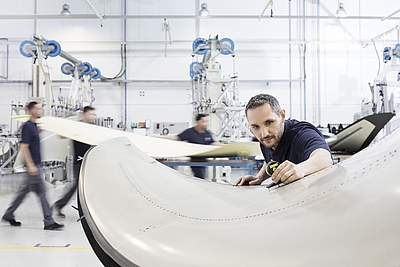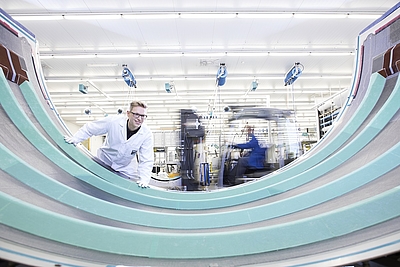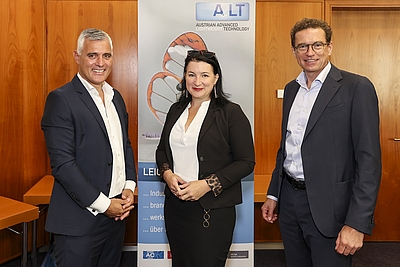The lightweight approach to climate action
13.06.2023
In Austria, lightweight construction is an ecological and economic heavyweight, generating 9.4 billion euros in added value and securing 77,400 jobs. It is also a key technology for climate action. These are the conclusions drawn by a study by economist Anna Kleissner, commissioned by A2LT.
As an interdisciplinary field, lightweight construction is a specific approach, a design mode that aims at reducing weight and, in turn, material and energy. This does not only pose technological challenges, it has also made it difficult to measure and visualise the economic dimensions of lightweight construction, expressed in terms of added value and employment.
Pilot study
This is why the A2LT lightweight construction platform and the industry division of the Upper Austrian Chamber of Commerce commissioned economist Anna Kleissner to carry out these computations in a study that is the first of its kind in Europe. The computations were based on a simplified data set encompassing the “enabling technologies”, “lightweight construction in the narrower sense”, “lightweight construction in the broader sense” and “lightweight construction including services” categories. The results were considered against the backdrop of three scenarios and have minimum to maximum bandwidth ranges. For example, direct added value ranges from a minimum of 8.8 billion euros to a maximum of 10.1 billion euros.
Interdisciplinary field
“Lightweight construction encompasses a large number of sectors and is therefore an interdisciplinary field, just like tourism, for example. This is why we need customised methods to reflect the overall economic significance of lightweight construction. It’s the only way to demonstrate that the overall economic importance of lightweight construction has been underestimated up to now,” says Anna Kleissner.
She also points to the above-average degree of innovation in lightweight construction:
“Austria achieves shares of global patent activity in glass composites (0.57%), wood composites (2.25%), foams (0.73%), plastic composites (0.66%) and metal composites (0.89%) that are significantly above the GDP share of 0.37%.”
An economic heavyweight
The direct value added by lightweight construction in Austria amounts to some 9.4 billion euros. Compared to other sectors, lightweight construction is bigger than mechanical engineering all told, and approximately equally as important as the entire hotels and catering industry. Every euro generated in lightweight construction triggers a further 0.74 euros of added value in the upstream and downstream value chain throughout Austria. Put together, a total of just under 16.4 billion euros is attributable to lightweight construction. In other words: every twenty-second euro generated in Austria can either directly or indirectly be attributed to lightweight construction.
Job creation
Expressed in terms of employment figures, the lightweight sector secures 77,400 jobs directly. Additionally, one job in the lightweight construction sector ensures at least another 1.4 jobs in other sectors of the economy: this means that lightweight construction safeguards nearly 186,000 jobs in total, which is equivalent to a share of 4.09 percent. Lightweight construction creates more jobs than the financial services sector or even the employment-intensive building industry.
Satellite account
Building on the results of the analysis, Anna Kleissner created what is known as a satellite account. This method has already proven successful in other interdisciplinary industries such as tourism or sports.
Kleissner points to the benefits: “The economic effects of lightweight construction can be seamlessly recorded, with each economic sector included to the extent of lightweight construction contributions. This avoids items being counted twice. Satellite accounts consider direct, indirect and induced effects and allow for comparisons across sectors, time, and even across countries.”
Harmonised throughout Europe
Lightweight construction satellite accounts need to be created at a European level, not just nationally, to make lightweight construction visible as an economic factor in a model which is harmonised throughout Europe. But this first requires a common definition as well as primary data acquisition, extensive secondary data research, and improvements in terms of data availability and quality. Kleissner also calls for a European impact analysis.
“We need the support of the large member states to lift analysis of the economic scope of lightweight construction to a European level,” the economist is convinced.
Key for climate action
Thanks to lightweight construction, cars and planes require less fuel, wind turbines become more powerful, and building increasingly conserves resources.
“Viewed over the product lifecycle, lightweight construction significantly reduces carbon emissions, thereby contributing to national and international sustainability targets”, Stefan Seidel, the CTO of Pankl Racing Systems and spokesperson for A2LT, the Austrian lightweight platform, notes.
The 21 members of the initiative, which was founded in 2014, are committed to working across industries and materials to promote affordable, sustainable and smart lightweight construction.
“Lightweight construction puts the key technology for energy and resource efficiency in our hands,” says Seidel.
Important for location resilience
The skyrocketing material and energy prices of recent months clearly demonstrate the importance of lightweight construction expertise for location resilience. This is also true if you look beyond mobility, which, although a driver of innovation, is by no means the only use case for lightweight construction. Using as little primary material as possible has the greatest potential in terms of CO2 savings, which explains why lightweight construction is also gaining in relevance in industries such as logistics. High-bay warehouses made of high-strength steels require less material, which translates to enormous savings in terms of energy and costs.
Smart, affordable, sustainable
“There are many such examples, but the basic idea is always the same: smart, affordable, and sustainable lightweight construction is possible and offers tangible savings if it is integrated from the outset. This is what we are looking to illustrate as a lightweight platform,” platform spokesman Seidel emphasises.
This is why the demand for lightweight construction technology is continuously increasing, as are the demands on companies and research institutions in Austria, whose expertise makes them sought-after partners world-wide. As a high-tech location, Austria has the opportunity of being the international pioneer in lightweight construction. One major strength is that expertise is available across the board within the country, from materials – such as metal, plastics, composites, and wood – through to production technology, both in research and in companies. This keeps the routes short.
Material and technology expertise
Higher-strength steels, aluminium, composite materials – less weight means lower energy consumption. But the fact that material structure also offers massive lightweight construction potential is less obvious. New manufacturing processes such as 3D printing can be used to build bionic structures inspired by nature which weigh less but are just as strong – regardless of the material. One example of this comes from Pankl itself: motorsports fans are familiar with the bar across the cockpit, also known as the “HALO”, which protects racing drivers against flying debris. Pankl uses 3D printing to build the titanium bar for the protective screen for the IndyCar racing series.
“This is a classic example of applied lightweight construction. The additive manufacturing process allows for great flexibility, fast implementation and low weight,” Seidel explains.
Pankl and several partners operate their own competence centre for additive manufacturing.
Mix of materials for electric mobility
Electric mobility shows how far lightweight construction can go and the extent to which it is replacing legacy thought processes. At present, electric vehicles still weigh considerably more than comparable combustion engine vehicles. But weight is a key criterion for the efficiency and range of the vehicles. The members of the Lightweight Platform are already researching and developing these forward-looking solutions. One example is the battery box, a central element of electric vehicles. This could be manufactured using different lightweight solutions in a mix of multiple materials, such as steel-based, cast aluminium or composite materials.
Thinking things through
With a view to the circular economy, lightweight construction is increasingly focusing on “design for recycling”. The trend is moving toward a holistic ecological view of technologies – from the production of materials and the product itself, through the ecological footprint during operation, to recyclability. Taken as a whole, lightweight construction is a key technology for achieving sustainability.
Strategic anchoring
One central goal of the A2LT lightweight construction platform is to cement the discipline of lightweight construction as a focus of funding in Austria’s RTI strategy.
“So far, aspects of lightweight construction can be found in mobility, production or energy research programs. But lightweight construction is interdisciplinary with a matching level of complexity, which is why we need support instruments that are tailored to it,” says Stephan Kubinger, Deputy Chairman of the industry division of the Upper Austrian Chamber of Commerce.
Every euro of research capital invested in lightweight construction technologies strengthens resilience, strengthens sustainability for Austria as a business location. In Upper Austria, for example, materials and materials technologies are some of the key technologies of the #upperVISION2030 economic and research strategy.


